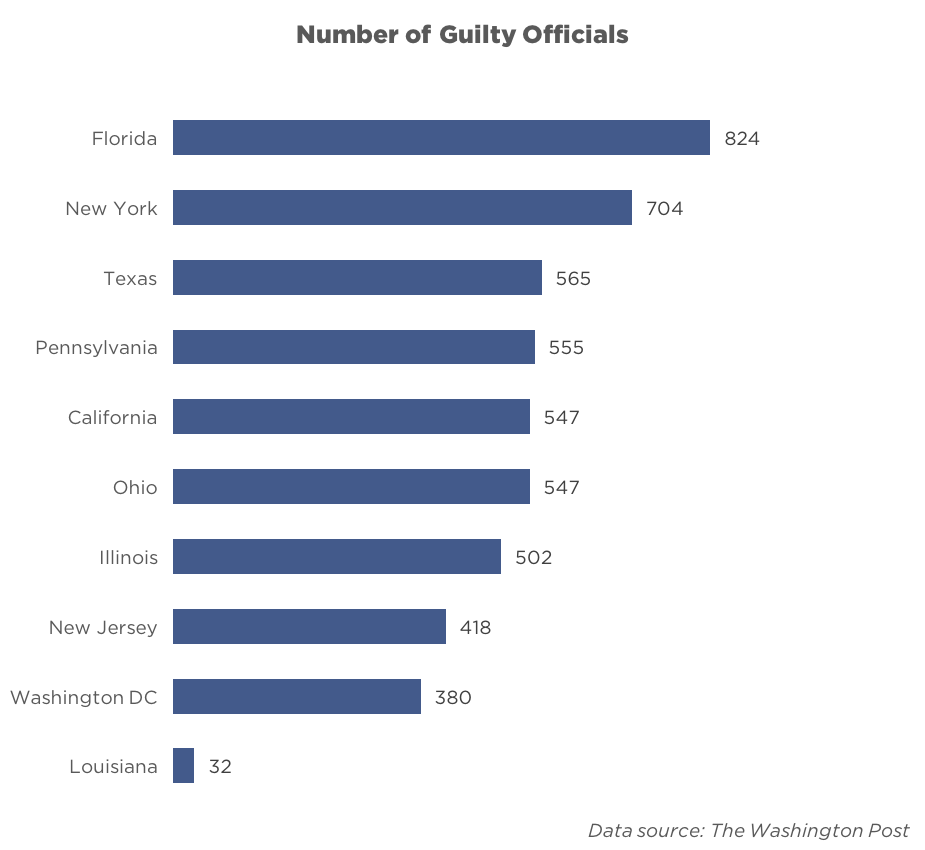It’s no secret that corruption lurks within the U.S. federal government. Throughout history, political machines and the spoils system have dominated U.S. politics, creating a culture of patronage that took decades to dismantle. Today, however, alternative forms of corruption have been on the rise. As University of Illinois at Chicago professor Dick Simpson told the HPR, although the presence of technology and coverage has changed, the levels of corruption have remained fairly similar, “rising and falling in some places, but overall stagnant.”
State governments, in fact, are considerably more corrupt than their counterparts on the national level. Due to the far-reaching influence of our national government and current investigations circulating mainstream media, the federal government is being scrutinized now more than ever. In turn, this national focus has led to apathy at the state level. State-level corruption is likely to directly or indirectly affect most Americans on a daily basis. Less attention is given to the proceedings of state governments and has more detrimental effects on the average American than one would initially believe. To better combat state-level corruption, we must understand both how it occurs and its numerous effects on the American population.
Defining Corruption
There are multiple ways to categorize corruption. At the base level is administrative corruption, which alters the implementation of policies and has some traces of the previous spoils system. Above administrative corruption is political corruption, which influences the establishment of laws and regulations. Although seemingly similar, administrative corruption occurs on a higher level and directly impacts the creation of legislation while administrative corruption simply just prevents proper implementation of legislation. The highest level is grand corruption — otherwise known as kleptocracy — typically involving substantial amounts of money and high-level officials. Petty corruption, by contrast, relates to the abuse of entrusted power by public officials in their day-to-day conduct with average citizens trying to access basic guarantees such as hospitals and schools; this can occur on a state, county, or local level.
Political corruption is present on both the federal and state level. At the national level, according to a survey conducted by Transparency International, “44 percent of Americans believe that corruption is pervasive in the White House.” In tandem with public opinion, according to the Justice Department, in the last two decades more than 20,000 public officials and private individuals were convicted for crimes related to corruption. However, an overwhelming majority of these cases came from the state and local level: considering the State Integrity Investigation’s comprehensive assessment of state government accountability, 13 states received an F, 34 received a grade of D, and three passed with a C. Forty-seven states have thus failed to maintain state integrity in areas such as budget transparency, government scandals, and crime by cabinet officials.
How Can One Gauge Corruption Objectively?
When comparing the 10 states with the highest rate of convictions of public officials and a studies on the most corrupt states in America, many states — Florida, Texas, Pennsylvania, Louisiana, and Alabama included — are found on both lists. Determining the corruption levels by state appears subjective, but there are many quantitative factors to consider. Undoubtedly, no system is perfect and the criminal justice system is no exception. Some argue that judges convict too many officials over corruption charges, contrastingly, others believe that they haven’t convicted enough. While it’s difficult to quantify perfectly, the rate of convictions of guilty officials serves as a valuable measurement tool.
One factor to consider is the sheer size of a state: understandably, a higher concentration of people cultivates a culture lacking accountability, in turn fueling more corruption. States such as California, New York, and Texas rank in the top ten for most convicted public officials, but are more densely populated than other places on that list such as Washington D.C. and Ohio. When measuring data sets, researchers thus need to scale corruption, population size, and the density of people in order to get comparable results.
A study completed by professor John Mikesell from Indiana University in partnership with professor Cheol Liu of the City University of Hong Kong, for example, attempted to identify the impact of a corrupt environment for public officials on state government finances. Mikesell told the HPR that there is “no perfect way to capture corruption completely and perfectly, but convictions provide a reliable criterion that is standard across time and states that can be used in empirical analysis.”

Another indication of corruption is the inequality of wealth. The enticement of economic gain via corruption wagers a huge audience in the state political scene. The feasibility of extorting public dollars to fund personal interests allows for wealthy citizens within the community to easily sway local politics. The widening wealth gap has fueled multiple in-depth studies into its effects. A recent study led by Philip Hans Franses and Bert de Groot studying the “corruption and inequality of wealth amongst the very rich,” for example, concluded that higher levels of corruption lead to increased inequality and poverty — meaning lowered incomes for those impoverished. For states that have larger income inequalities, it can be expected there is a higher rate of corruption in that area.
Centralization and the Downfall of Local News
The presence of technology in this era has changed the amounts of coverage that state-level news receives. But despite a decline in state news outlets, the levels of corruption have actually remained fairly similar. The United States has remained fairly constant in terms of corruption rates. According to the 2017 Corruption Perceptions Index reported by Transparency International, the United States was measured to be the “16th least corrupt nation out of 75 countries.” From 1995 to 2017 the United States averaged out to be ranked around 17.70 in terms of the least corrupt states. Comparing the past to the present, there has been little fluctuation surrounding corruption levels in the United States. Thus, there is no direct correlation between the development of technology and corruption.
Still, however, technology is inadvertently affecting state-level news outlets. Citizens are increasingly turning to online news sources to retrieve information. But, because online news is overwhelmingly dominated by larger, national corruptions that have less of a focus on community-centered issues, state-level coverage is dwindling.
Retrieving news from a centralized source can increase reliability, provide easy access for online articles, and increase global consciousness. However, relying on larger corporations to provide updates on events can also have negative ramifications. Auston Stewart, a technologist with experience in tech companies such as Apple and Twitch, told the HPR that this lack of community awareness is due to the fact that “our news has been centralized and subjected to the algorithmic approaches of determining what’s relevant to people.” In fact, because “those algorithms are frequently made without respect to what local issues are, when they do try to provide you with news relevant to you, it hasn’t been curated by someone invested in that community. It’s made by someone who’s looking to create for multiple communities at once, but we need to remember that not all communities have the same issues.”
The recent decline in community-centered media contributes to less awareness. As Simpson mentioned, “news media is a check and balance that serves to help correct corruption, it plays a large role in the stimulating dialogue.” Directing our attention to centralized news sources focuses our energy and outrage towards the latest national scandal, leading people to forget that there are issues occurring in their backyard that are more deserving of their attention. “We leave a space for corruption by creating an apathy to local issues as our attention is drawn to trivial national politics,” Stewart noted. Our livelihood rests in our knowledge of what’s happening on the ground, right where we live.
High levels of corruption — particularly when unnoticed — can undermine democracy, divert resources from average citizens, and disrupt the progress of law and social justice. Corruption also has a literal cost, Simpson mentioned that in the state of Illinois, “taxpayers pay more than $500 million in a corruption tax every year.” Taking away hard-earned money and resources from the bulk of the population and presenting it to corrupt officials. Of course, there’s more than just a monetary cost that citizens pay, Simpson cited a loss of life and a loss of trust in governments where corruption runs rampant. Corruption actively damages citizens’ trust in political institutions, it’s detrimental to the trust of citizens and their investment in civic involvement.
The decline in state media coverage has led to the end of an era. By removing this essential component for accountability, it has effectively removed a watchdog amongst officials.
Hope For The Future
Nonetheless, state-level corruption need not go unnoticed. According to a study by Filipe R. Campante and Davin Chor on the correlation between educational level and political participation, corruption causes a decrease in government expenditures on public goods, for example, there would be less government spending on health care and increased spending on preferred projects. Mikesell’s research also supports this; corruption correlates with a distortion of public resource allocations in favor of “bribe-generating” spending. Improvement in education can thus help reduce corruption because educated citizens are more likely to stay informed and civically engaged, resulting in the population being more able to identify corrupt activities.
In addition, encouraging media coverage at the state level is vital to combating corruption. The advance of technology demands accountability, promoting coverage will encourage the local population to stay informed. Individuals can also play a large role through social activism and encouraging free speech, thus facilitating much-needed dialogue about corruption within their state. On the big stage, the federal government can promote legislation that allows public access to government information that would increase transparency and reduces opportunities for corruption.
Getting people talking and starting a dialogue is likewise important for holding state level officials accountable. A study by Transparency International in 2017, for example, reveals that 75 percent of ordinary people feel that they can make a difference in the fight against corruption. Proactively disclosing information relevant to public interests promotes more trust within the community and allows citizens to identify patterns of corruption more efficiently. Implicating direct enforcement of ethics laws would greatly improve transparency as the entities responsible for overseeing ethics are often ineffective.
Ultimately, it is important to push for greater transparency from our elected officials by holding them accountable. This citizen responsibility is a crucial part of holding politicians responsible to the people they are charged with serving.
Image Credit: Ted Eytan / Wikimedia Commons
